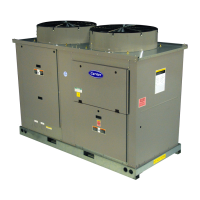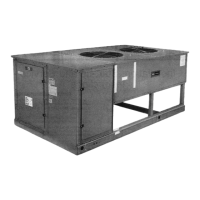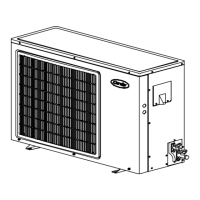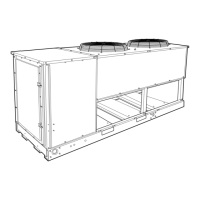2
CONTENTS (cont)
Page
MAINTENANCE . . . . . . . . . . . . . . . . . . . . . . . . . . . . . . . . . . . 161
Recommended Maintenance Schedule. . . . . . . . . . . . 161
Lubrication . . . . . . . . . . . . . . . . . . . . . . . . . . . . . . . . . . . . . . . 161
• CONDENSER FAN BLADES
• CONDENSER FAN MOTOR BEARINGS
• DOOR HINGES
Microchannel Heat Exchanger (MCHX) Condenser
Maintenance and Cleaning
Recommendations . . . . . . . . . . . . . . . . . . . . . . . . . . . . . 161
Navigator
™
Display Module . . . . . . . . . . . . . . . . . . . . . . . 161
Refrigeration Circuit . . . . . . . . . . . . . . . . . . . . . . . . . . . . . . 161
• LEAK TESTING
• CHARGING
Ground Fault Interrupter-Convenience Outlet
(GFI-CO) . . . . . . . . . . . . . . . . . . . . . . . . . . . . . . . . . . . . . . . . 161
TROUBLESHOOTING . . . . . . . . . . . . . . . . . . . . . . . . . 162-175
Alarms and Alerts. . . . . . . . . . . . . . . . . . . . . . . . . . . . . . . . . 162
• RESETTING ALARMS
• ALARM HISTORY
• ALARM AND ALERT DETAILS
APPENDIX A — DISPLAY TABLES . . . . . . . . . . . . 176-194
APPENDIX B — CCN TABLES . . . . . . . . . . . . . . . . . 195-209
APPENDIX C — BACNET COMMUNICATION
OPTION. . . . . . . . . . . . . . . . . . . . . . . . . . . . . . . . . . . . . 210-218
APPENDIX D — PIPING AND INSTRUMENTATION
DIAGRAMS . . . . . . . . . . . . . . . . . . . . . . . . . . . . . . . . . 219-224
APPENDIX E — CONTROL METHODS WITH
INPUTS FOR CONTROL MODE
COMPARISON . . . . . . . . . . . . . . . . . . . . . . . . . . . . . . 225, 226
INDEX. . . . . . . . . . . . . . . . . . . . . . . . . . . . . . . . . . . . . . . . . 227, 228
START-UP CHECKLIST FOR 38AP SPLIT SYSTEM
CONDENSING UNIT. . . . . . . . . . . . . . . . . . . . CL-1 to CL-14
SAFETY CONSIDERATIONS
Installing, starting up, and servicing this equipment can be
hazardous due to system pressures, electrical components, and
equipment location (roof, elevated structures, mechanical
rooms, etc.). Only trained, qualified installers and service
mechanics should install, start up, and service this equipment.
When working on this equipment, observe precautions in
the literature, and on tags, stickers, and labels attached to the
equipment, and any other safety precautions that apply. Follow
all safety codes. Wear safety glasses and work gloves. Use
care in handling, rigging, and setting this equipment, and in
handling all electrical components.
WARNING
Electrical shock can cause personal injury and death. Shut
off all power to this equipment during installation and
service. There may be more than one disconnect switch.
Tag all disconnect locations to alert others not to restore
power until work is completed.
WARNING
DO NOT VENT refrigerant relief valves within a building.
Outlet from relief valves must be vented outdoors in
accordance with the latest edition of ANSI/ASHRAE
(American National Standards Institute/American Society
of Heating, Refrigeration and Air-Conditioning Engineers)
15 (Safety Code for Mechanical Refrigeration). The
accumulation of refrigerant in an enclosed space can
displace oxygen and cause asphyxiation. Provide adequate
ventilation in enclosed or low overhead areas. Inhalation of
high concentrations of vapor is harmful and may cause
heart irregularities, unconsciousness or death. Misuse can
be fatal. Vapor is heavier than air and reduces the amount
of oxygen available for breathing. Product causes eye and
skin irritation. Decomposition products are hazardous.
WARNING
DO NOT attempt to unbraze factory joints when servicing
this equipment. Compressor oil is flammable and there is
no way to detect how much oil may be in any of the
refrigerant lines. Cut lines with a tubing cutter as required
when performing service. Use a pan to catch any oil that
may come out of the lines and as a gage for how much oil
to add to system. DO NOT re-use compressor oil.
WARNING
DO NOT USE TORCH to remove any component. System
contains oil and refrigerant under pressure.
To remove a component, wear protective gloves and gog-
gles and proceed as follows:
a. Shut off electrical power to unit.
b. Recover refrigerant to relieve all pressure from sys-
tem using both high-pressure and low pressure
ports.
c. Traces of vapor should be displaced with nitrogen
and the work area should be well ventilated. Refrig-
erant in contact with an open flame produces toxic
gases.
d. Cut component connection tubing with tubing cutter
and remove component from unit. Use a pan to
catch any oil that may come out of the lines and as a
gage for how much oil to add to the system.
e. Carefully unsweat remaining tubing stubs when
necessary. Oil can ignite when exposed to torch
flame.
Failure to follow these procedures may result in personal
injury and death.
CAUTION
DO NOT re-use compressor oil or any oil that has been
exposed to the atmosphere. Dispose of oil per local codes
and regulations. DO NOT leave refrigerant system open to
air any longer than the actual time required to service the
equipment. Seal circuits being serviced and charge with
dry nitrogen to prevent oil contamination when timely
repairs cannot be completed. Failure to follow these proce-
dures may result in damage to the equipment.

